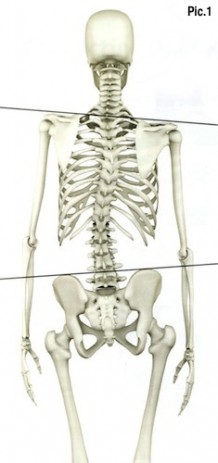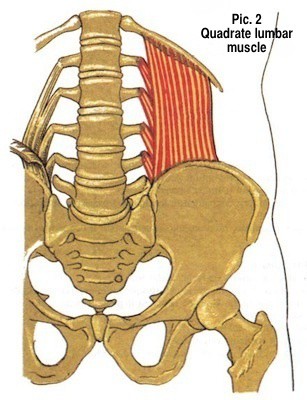Scoliosis is a frontal curvature of spine that, depending on its gravity, considerably restricts the mobility of vertebral disks, causes deformation of vertebral bodies and frank asymmetry of the body (Picture 1). Deformation of spine pinches the nerve roots, resulting in chronic pains in the spine, in grave cases leading to apoplexy of lower limbs. Scoliosis is a progressing illness, sooner or later leading not only to spine deformation, but also to malfunction of blood circulation and external respiration. Load distribution on locomotorium is changed dramatically, a costal humpback grows, breast deforms, reducing the internal cavities and lungs excursion, external breathing deteriorates. Ventilation problems in their turn, have a negative impact on anaerobic (cellular) breathing, and deterioration of cellular metabolism leads to chronic hypoxia of tissues. Chronic hypertension in pulmonary circuit can lead to cardiac hypertrophy of right cardiac chambers and develop the symptoms of pulmonary heart disease (“kyphoscoliotic heart”).
Despite the variety of treatment methods, Scoliosis still holds the status of an irremediable disease, because its prime cause haven’t been discovered yet. It can be cured on initial stages in younger age, when the bones are still formed. However, after the organism has developed, correct yoga therapy can only stop the development of the disease and significantly improve the quality of living. At the same time, unadapted asanas practice can bring a number of epiphenomena and traumas to those suffering from this disease, up to enhancing the asymmetry. This article is going to be dedicated to the ways of adapting yoga practice for people who have Scoliosis and the first thing that can help us is the knowledge of the subject.
Thus, the first misleading lie: “The cause of Scoliosis is our incorrect posture at school”.
It is actually the other way round: those who already had curvature sat incorrectly. Crooked position is an adaptive reaction to asymmetric weight load in our body. It is a consequence, not a reason. Trying to hold an upright position will only increase tension in those areas, which are already quite tense. So what this knowledge gives to us? Using corrective postures won’t give the necessary effect. At least, if you just curve to the opposite side and freeze like this for a long time, you will get convulsions, traumas, muscle spasms and pain syndrome.
The second lie: “Scoliosis is down to weak back muscles, so they should be trained”.
The curvature is characterized by more or less evident changes in force balance, the muscles become longer o shorter. Depending on the direction of turning or twisting, the body loses the balance of muscle strength and flexibility. In 1962 a German doctor, Friedrich Brussatis described the difference in electric activity of the muscles of the salient and concave side. He discovered that the muscles on the salient side are more active. It means that muscles on the concave side are weaker and they should be trained. At the same time, the salient side muscles are overstrained and they should be relaxed.
The truth you should know: A muscle loses its functional length when it is constantly, but not extremely, strained. This length could allow it both to contract and extend effectively. From the salient side the muscles become contracted and shortened. When you try to load them more, they cannot develop more strength and contract. Instead they give in to tremor and convulsion. This is called strain weakness disorder. If we try to relax those muscles by lengthening them it becomes obvious that the strongest part of the muscle, its central part, also stretches the weakest, tendon end. It forms overstrained and contracted as well as lengthened areas in one and the same muscle.
This can be explained by the muscle mechanics. There is difference between muscle intention (pre-strain) and muscle contraction. The muscle can achieve its maximum tension only after some pre-stretching, what is approximately equal to the length in quiescent state. Overstretching reduces the contractive capacity of potential tension. Therefore, constant asymmetric load makes muscles of both sides lose their functional length that could help them contract or lengthen effectively. It means that if we try to stretch the salient side muscles and contract those on the concave one, there will be no effect until the muscles regain their functional length.
Attention! Here is the key point in working with lateral curvature.
You can show utmost zeal selecting asymmetric exercises for the very muscle groups that are involved in the very curvature you work with, but there will be no effect until you restore the functional length of the muscles. For this purpose it is better to use dynamic exercises without ultimate load, alternating lengthening and contraction. These exercises are called vyayamas in hatha-yoga. The exercises should be done asymmetrically, as there is a chance of “cheating” effect, when an exercise is fulfilled with the help of overstrained and spasmed muscles of the salient side, not involving the weakened side.
It can be illustrated by an example.
Here is left-side lumbar scoliosis. Quadrate muscle of waist, which starts from iliac crest and is fixed upon the 12th rib and transversal appendices of lumbar vertebras, is shortened and overstrained (Picture 2).






